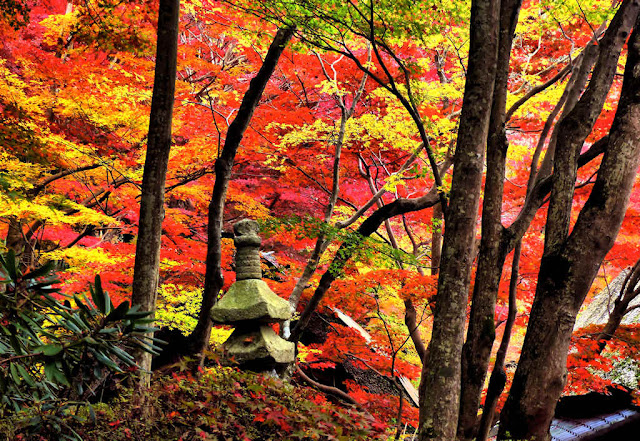Thursday November 24th, 2016, day 39 of my walk along the Saigoku Pilgrimage, and I descended from Kannonshoji Temple in the mountains near Omihachiman in Shiga.
I visited Kyorinbo, a famous spot for Fall Colours and as I had come down the mountain I entered the property through the rear entrance.
Kyorinbo is a Tendai Temple, though it doesn't look like a temple.
It is said the temple was founded in 605 by none other than Shotoku Taishi.
A small statue of Kannon said to be carved by him is the honzon of the temple and is enshrined in a small cave in the grounds.
The temple was destroyed during the Warring States Period but was rebuilt in 1585.
The Shoin, Main Gate, and Storehouse all date from the early Edo Period and are thatched.
The Shoin has two gardens, one to the south, and one to the west.
The one to the south is called the Fudaraku Garden. It contains a path that runs to the main hall and also the cave holding the Kannon statue.
It is also the garden where most of the maple trees are planted. It was created in the Muromachi Period (1338 to 1573).
The garden to the west is attributed to Kobori Enshu and is believed to date from the early Edo Period.
It is a pond garden with a hillside of moss-covered stones.
Kyorinbo has the nickname of Stone Temple.
The Enshu Garden features a "dry waterfall" and the pond contains the classic Crane and Turtle stone arrangements.
The garden can be appreciated any time of the year, but with the Fall colours it becomes ablaze with colour.
For much of the year, the garden is closed but opens on the weekends and holidays in the Spring and daily during November.
In November the garden is illuminated and open in the evenings.
The temple was abandoned and derelict in the late twentieth century but a monk almost singlehandedly restored it.
The closest train is Azuchi Station where taxis and rental bicycles can be found.
If you would like to subscribe by email just leave your email address in the comments below. It will not be published and made public. I post new content almost everyday, and send out an email about twice a month with short descriptions and links to the last ten posts.


































































